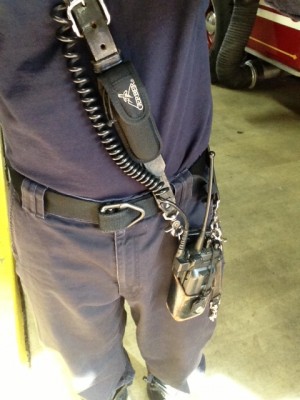How do you wear your handheld radio? Do you even wear one? Do you use a strap? Do you use a radio pocket on your coat? Do you care? Do you have a reason why you wear it one way or another?
I care…that is, I care about how I wear my radio. I wear it a certain way, the way I like it. I wear a radio strap on my right shoulder hanging down to below my left hip. I am right handed and access the radio with my left hand. Oh…and I put the radio in its hoster backwards facing in. I also wear the strap under my coat, with the mic sticking out the top of my coat and hanging down a couple of inches. I wear an anti-sway strap to keep it in place and keep it from swinging too far front. The Gerber sheath is for a knife.

The way I wear my radio strap. I turn the radio face in and place it in the holster. Does anyone have a reason not to do this.
I bet Fairfax didn’t think about that when they did their report (wearing the radio facing in). I do it for the simple reason that the cord comes off the right side of the radio and when I turn the radio facing in, it follows the line of the radio strap closer. Call it aesthetics, it is what I do and I have never read anything about this placement being negative.
I don’t have to visualize my radio in order to use it. Our radios give an audible beep when you change the channels so I can tell what channel I am on by how many beeps there are moving from the main channel.
The Fairfax County Fire & Rescue Department released a very detailed report “Portable Radio Placement in the IDLH” on the pros and cons of wearing your radio in a strap under the coat vs. in a coat pocket. You can read that report here (.pdf).
P.J. Norwood recently wrote about the radio debate on FireEngineering.com
Much like everything else Fairfax County does, they didn’t spare any expense at providing a thorough and detailed report…then openly shared it for all Firefighters to learn from.
I recently posed this question on the Fire Critic Facebook Fan Page and was amazed at how many people wore a radio strap EXCEPT for with turnout gear. I can’t imagine having to change how I wore my radio depending on the call I got. Some departments, oddly including Fairfax County, PROHIBIT the use of radio straps.
Fairfax County Fire & Rescue Department released a General Order in 2009 mandating the turnout coat radio pocket as the only way to carry the radio. Montgomery County (MD) Fire & Rescue have a similar policy. – from the report
There is a ton of great information and data in the report. I suggest you read it in its entirety and forward it to your Chief and Safety Officer for their review.
Here is the Conclusion from the report:
Firefighter Safety and Communications is synonymous. The ability to have reliable communications on the fire-ground is critical to the safety of the firefighters operating in the IDLH. Dependable communications can save a firefighter’s life or prevent a bad situation from getting worse.
Although the Radio Pocket has been integral to the bunker coats for many years, recent hard looks and analysis have proved that there are significant dangers associated with using the radio pocket. Whether it is signal loss from the antenna being too close to the body or the inability for the closure to keep the radio in the pocket or exposure of the Remote Speaker Mic to thermal insult potentially locking the tactical channel from everyone on the fire-ground, it is clear that just one of the negative factors is too much risk for our firefighters. Having all three major factors endangers our firefighters to an exponentially high level.
The negative results from the Radio Pocket are clearly identified and proven. Any concerns about the viability of the recommended best practice of wearing the portable radio RSM under the coat, but hanging the radio below the coat line with the antenna canted away from the body would be purely speculation. A recent close call fire where a fire officer fell through the 2nd floor onto the first floor, prove that in a real-life dynamic fall, the radio stayed in place, as he was wearing it under the coat. Wearing the radio in this fashion is not new and no direct connection to this manner of carrying radios has produced a negative effect, as evidenced by the numerous safety issues experienced with the radio pocket.
Entanglement issues are eliminated, Radio signal loss is improved, the RSM is protected, and access to the controls is at hand. The ability to disconnect the RSM, if practical, is still there and arguably easier. An attempt to bypass a damaged RSM by depressing the PTT button on the radio itself is still available by tilting the radio up and talking down to the portable.
There is simply no valid reason to object to the practice that has been identified. In fact, with the identified critical safety issues associated with the radio pocket, beyond the potential of injury or death to firefighter, the opportunity to litigious liability is too great. There is no way to avoid the liability of such an obvious safety issue.
By committing to sounding the alarms against the Bunker Gear Radio Pocket, the safety for firefighters is increased not only for an individual user, but the entire fire-ground.
 Fire Critic An Unadulterated View of the Fire Service
Fire Critic An Unadulterated View of the Fire Service




